![]()
![]()
![]()
Use LEFT and RIGHT arrow keys to navigate between flashcards;
Use UP and DOWN arrow keys to flip the card;
H to show hint;
A reads text to speech;
107 Cards in this Set
- Front
- Back
|
What synapomorphy defines clade synapsida?
|
1 temporal fenestra surrounded by postorbital, jugal, and squamosel
|
|
|
Which period did the synapsids originate?
|
carboniferous
|
|
|
After which period were most synapsids extinct?
|
Permian
|
|
|
Is pelycosaurs a grade or clade?
|
grade
|
|
|
is therapsids a grade or clade?
|
clade
|
|
|
What is the basal lineage of pelycosaurs?
|
caseids
|
|
|
Describe the caseids
|
small head with pointy nose and big nostril, herbivore
|
|
|
What evidence proves that caseids were herbivores?
|
spatulate teeth, barrel-chest for storing and fermenting plant material
|
|
|
Though the caseids were herbivores, the majority of basal pelycosaurs were carnivorous, name one and describe the skull
|
ophiacodon, narrow hatchet skull
|
|
|
Name the two derived lineages of the pelycosaurs
|
edaphosaurs and sphenacodontids
|
|
|
What evidence was there for edaphosaurs to have thermoregulation?
|
spines beared groves for blood vessels--skin covered
|
|
|
Were the edaphosaurs herbivores or carnivores?
|
herbivores
|
|
|
Were the sphenocodontids herbivores or carnivores?
|
carnivores
|
|
|
What was the difference between the spine of the edaphosaur and sphenocodontid?
|
edaphosaur-neural spines have crossbars
sphenocodontids did not |
|
|
What limb position was used by all pelycosaurs?
|
sprawling
|
|
|
What was the evidence that pelycosaurs used sprawling limb position?
|
shoulder socket of the scapula directed out to the side, head of humerus fits so bone sticks out horizontally
|
|
|
Describe the differences between pelycosaurs and therapsids: teeth, skull slope, postdentary bones
|
pelycosaurs: lots of canine teeth, rear skull slopes forward, large lower jaw postdentary bones
therapsids: single large canine tooth, rear skull slopes backward, small lower jaw postdentary bones |
|
|
What do the pelycosaurs and therapsids skull differences reveal?
|
therapsids have larger temporal fenestra (brain), and more jaw consolidation (more food processing)
|
|
|
Describe the differences in limb position of pelycosaurs and therapsids
|
pelycosaurs: sprawling
therapsids: mroe upright |
|
|
Name the two basal therapsids and describe
|
dinocephalians- herbivores, thick skulls
dicynodonts- herbivores, most permian fauna, tusks instead of teeth |
|
|
Name the two derived therapsids and describe
|
gorgonopsians- dominant predators of permian, sabre canine teeth, flat skull with temporal fenestra expanded fore-aft; tiger-sized
cynodont- smaller bodies and large temporal fenestra; includes mammals |
|
|
Which therapsids include mammals?
|
cynodonts
|
|
|
What jaw feature do gorgonopsians and cynodonts share?
|
coronoid process for jaw closing
|
|
|
Name the eight trends in synapsid evolution
|
1. expansion and differentiation of jaw closing muscles
2. differentiation of teeth 3. formation of secondary palate 4. jaw bones to ear bones 5. upright limb posture 6. shortening of tail 7. loss of rear ribs 8. nasal turbinate bones |
|
|
Describe the basal jaw closing muscles of the pelycosaurs: temporal fenestra, coronoid, skull, jaw closing muscle
|
small temporal fenestra, low coronoid process, narrow skull, single jaw closing muscle (adductor mandibulae)
|
|
|
Describe the evolution of the three jaw closing muscles in therapsids
|
1. appearance of wide zygomatic process and masseteric fossa-->masseter muscle
2. bigger temporal fenestra-->temporalis muscle 3. pterygoideus muscle |
|
|
What does the masseter muscle do?
|
close jaw up and out to the side
|
|
|
What does the temporalis muscle do?
|
pulls jaw up and back
|
|
|
What does the pterygoideus muscle do?
|
pulls jaw up and in
|
|
|
What kind of motion does the masseter, temporalis, and pterygoideus muscles enable therapsids to have?
|
rotary--more efficient food processing
|
|
|
Describe the differences in teeth between pelycosaurs and therapsids
|
pelycosaur- homodont dentition
therapsids- heterodont dentition (incisors, canines, cheek teeth) |
|
|
What are the advantages of the formation of a secondary palate in therapsids?
|
structural reinforcement against chewing forces, separates air and food passages--> allows breathing w/ food in mouth
|
|
|
Describe the movement of jaw bones to ear bones in therapsids
|
stapes forms as new bone
quadrate bone--> incus articular bone--> malleus typanum (ear drum) |
|
|
What does the shortening of the tail indicate in therapsids?
|
shift of leg retractor muscle location from tail to pelvis (gluteals) to reduce drag and make more upright
|
|
|
What does the loss of lumbar ribs in therapsids indicate?
|
presence of a diaphragm
|
|
|
Describe the new nasal turbinate bones in therapsids
|
thin scrolls of bones covered in moist tissue warms and moistens air on way in and extracts water and warm air on way out
|
|

name this basal lineage and what it is the basal lineage of
|
caseid; pelycosaur
|
|
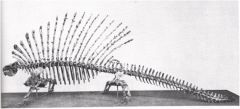
Name this species and what it is a derived lineage of
|
edaphosaur; pelycosaur
|
|

Name this derived lineage and what it is a derived lineage of
|
sphenadontid; pelycosaur
|
|
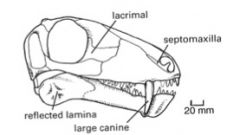
Whose skull is this?
|
therapsid
|
|
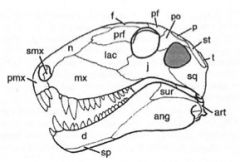
Whose skull is this?
|
pelycosaur
|
|
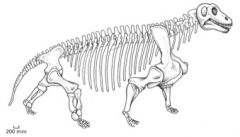
What basal lineage is this and what is it the basal lineage of?
|
dinocephalian
|
|
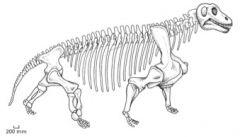
What basal lineage is this and what is it the basal lineage of?
|
dinocephalian; therapsid
|
|
|
What are the mammal synapomorphies?
|
1. hair
2. mammary glands/lactation |
|
|
What evidence is provided that early mammals had fur?
|
Harderian glands--issue secretions to be spread over fur
|
|
|
What are some distinctive features of mammalian dentition?
|
1. heterodont dentition
2. cheek teeth fit prefectly together--occluding 3. cheek teeth divided into molars and premolars 4. cheek teeth have two roots 5. diphydonty--only one set of replacement teeth |
|
|
Which parts of the brain were enlarged in mammals?
|
hearing and smell-nocturnal?
|
|
|
What evidence suggests that mammals have determinant growth?
|
1. growth plate (dark line where bone replaces cartilage)
2. epiphyses (the bone capping the growth plate--fuses to shaft to end growth) |
|
|
Name the parts of the mammalian vertebrae
|
1. cervical (7)
2. thoracic (ribs) 3. lumbar 4. sacral (fused to pelvis) 5. caudals (tail) |
|
|
How is hair formed in the integument of mammals?
|
epidermis grows into dermis
|
|
|
What are hairs mammals use for sensing called?
|
vibrissae
|
|
|
How does hair provide insulation for mammals?
|
arrector pili muscle raises hairs to trap more air
|
|
|
amoxicillin
|
moxatag
class: antibiotic, penicillin Dose: 250-500mg tid Indication: Sinusitis, respiratory tract infection, skin infection and UTI. |
|
|
Describe the function of the subaceous glands in mammals?
|
oily secretion associated with hair over whole body to waterproof hair
|
|
|
Describe the function of the apocrine sweat glands in mammals?
|
chemical/scent secretion associated with hair; provides sweat for cooling in many mammals
|
|
|
How do mammary glands develop?
|
from milk ridges running along the abdomen from armpit to groin; can be on all or only part
|
|
|
Describe the structure of mammary glands
|
complicated branching structure
|
|
|
Which aortic arch did the aorta originate from in mammals?
|
left 4th
|
|
|
Describe the blood circuit in mammals
|
right atrium-->right ventricle--> pulmonary arteries--> lungs--> pulmonary veins--> left atrium--> left ventricle--> aorta--> body
|
|
|
What are two distinctive features of the mammal respiratory system?
|
1. alveolar lungs
2. diaphragm (contracts--> +vol, -pressure) |
|
|
Name two distinctive features of the mammal excretory system
|
1. urinary bladder-stores nitro waste as urine
2. Loops of Henle-allow water extraction from waste |
|
|
Describe the mammalian adaptations to the brain
|
1. enlarged cerebrum-frequently infolded
2. prominent olfactory region |
|
|
Describe the mammalian adaptations to the eyes (with exception of primates)
|
1. lots of rods (light perception)
2. only has cones for sharp focus in fovea region 3. nocturnal evidence |
|
|
Describe the mammalian hearing adaptations
|
1. pinna- outer ear (helps funnel sound)
2. cochlea- gradation of sensory cells allows fine distinction of sound frenquency |
|
|
Name the 2 most basal clades of mammalia
|
morganucodontids, multituberculates
|
|
|
Name the clades that make up mammalia
|
monotremata, metatheria (marsupials), eutheria (placental mammals)
|
|
|
Describe the multituberculates-teeth, lifestyle
|
1. no canines, long incisors, blade like lower premolars, rowed cusps on molars
2. arboreal (prehensive tail, reversible ankle) |
|
|
How many species of monotremes are there and where are they found?
|
3; Australia, New Guinea
|
|
|
What are the plesiomorphic traits kept by monotremes?
|
1. lay eggs
2. cloaca 3. no nipples |
|
|
Name two examples of monotremes
|
platypus, spiny anteater
|
|
|
What are the six synapomorphies uniting eutheria and metatheria?
|
1. live birth
2. nipples 3. seperate digestive and urogenital openings (no cloaca) 4. tribosphenic molars 5. new scapular spine 6. loss of interclavicle and bones fusing shoulder girdle across belly |
|
|
Describe occlusion in theria
|
cusps fit into basins--upper tooth fits between 2 lower teeth
|
|
|
What is the purpose of the new scapular spine in theria?
|
increases muscle attachment
|
|
|
What is the purpose of the loss of the interclavicle and bones fusing shoulder girdle across belly in theria?
|
lets scapula move and adds extra stride length
|
|
|
What distinguishes eutherians?
|
chorioallantoic placenta
|
|
|
Name the two basal clade of eutherians
|
Xenarthra and Pholidota
|
|
|
Which animals make up clade Xenarthra?
|
29 species; sloths, anteaters, and armadillos in north and south america
|
|
|
Describe features of the Xenarthra--teeth, foreclaws
|
1. have xenarthrae (extra articulations between vertebrae)
2. reduced teeth 3. big foreclaws (digging, hanging, defense) |
|
|
Which animals make up clade Pholidota?
|
pangolins; 7 species in africa and asia
|
|
|
Describe features of Pholidota--body, teeth, tongue, tail
|
1. scaly covering of body
2. reduced teeth 3. long tongue 4. flexible tail |
|
|
What is sister taxa to rodents?
|
lagomorphs
|
|
|
Describe teeth of rodents
|
ever-growing upper and lower incisors with enamel in front--gnawing
|
|
|
What animals are rodents?
|
1700+ species; beavers, squirrels, mice, rats, guinea pigs, porcupines
|
|
|
Describe lagomorph dentition
|
two upper incisor sets one behind the other with single lower set
|
|
|
What animals are lagomorphs?
|
rabbits
|
|
|
Which animals are insectivores?
|
400 species; hedgehogs, shrews, moles
|
|
|
Describe insectivores--size, teeth, snout, eyes
|
1. small
2. sharp pointy teeth 3. long, sensitive snout 4. small eyes |
|
|
sister clade to bats?
|
primates
|
|
|
How many bat species are there?
|
1000
|
|
|
bats: megachiropterans vs. microchiropterans
|
megachiropteran- fruit eating; large
microchiropteran- uses echolochation to find objects; small |
|
|
Which animals make up primates?
|
apes, lemurs, monkeys, humans, etc; 200 species
|
|
|
Describe traits of primates-claws, teeth, vision/eyes
|
1. nails
2. generalized teeth--omnivorous 3. good color vision and depth perception (frontally directed) |
|
|
Which animals make up carnivores?
|
dogs, cats, bears, mustelids, raccoons, pinnipeds; 270 species
|
|
|
What feature unites ungulates?
|
hooves; thick keratin overlying ungual phalanx--walk on toes
|
|
|
Which animals are ungulates?
|
280 species; elephants, giraffes, whales, horses, rhinos, tapirs, bovids, moose, deer, pigs, dolphins, manatees
|
|
|
Explain the female urogenital anatomy in monotremes
|
ureters from kidney drain urine to the base of the uterus (can backwash)
|
|
|
Explain the female urogenital anatomy in marsupials and most eutherians
|
ureters from kidney drain urine directly to bladder; there is still a common tract exit (urogenital sinus); the rectum is separate (no cloaca)
|
|
|
Explain the female urogenital anatomy in primates
|
3 seperate openings for the uterus, bladder, and rectum
|
|
|
Describe the placenta of marsupials
|
use yolk sac placenta--no mesodermm for blood vessels, limited attachment, short gestation
|
|
|
Describe the placenta of eutherians
|
use chorion and allantois--has mesoderm-->strong vascular connection to mother, long gestation
|
|
|
List the anatomical changes toward a cursorial lifestyle in theria
|
1. limbs lengthened by the lengthening of foot bones and raising foot more off ground
2. reduce number of toes--lightens weight at end of foot |
|
|
Describe ruminants
|
foregut fermenters--cows and deers--has extra stomach chamber called the rumen, may regurgitate fermented food to be chewed again; extracts more energy
|
|
|
Describe hindgut fermenters
|
horses, elephants, rabbits, many rodents--has caecum (extra chamber off intestine; faster at getting energy out
|
|
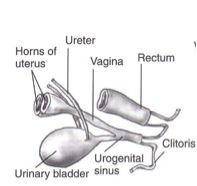
Whose female urogenital anatomy is this?
|
marsupials and most eutherians
|
|
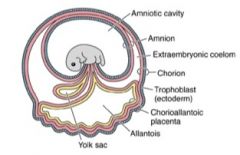
Whose placenta is this?
|
eutherians
|
|
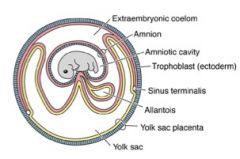
Whose placenta is this?
|
marsupials
|
|
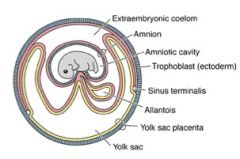
Whose placenta is this?
|
marsupials
|

